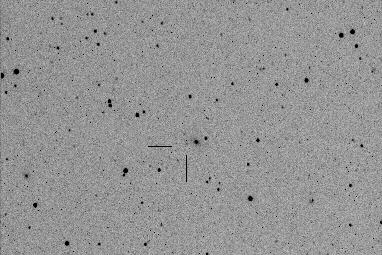
Olathe, Kansas
Larry Robinson

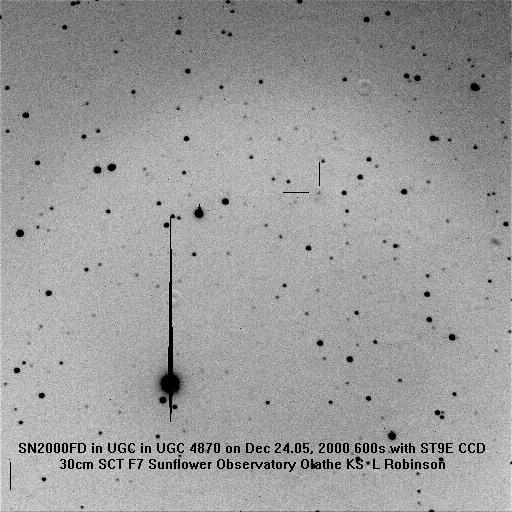
A composite image of this supernova from Sunflower Observatory.
SUPERNOVA 1999fd In UGC 4870

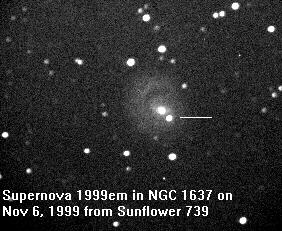
A composite image of this supernova from Sunflower Observatory.
SUPERNOVA 1999em In NGC 1637
According to IAUC 7294, the LOSS KAIT term has discovered a bright >(mag 13.5) supernovae in very nearby (about a half way to Virgo >cluster) galaxy NGC 1637. The coordinate is: R.A. = 4h41m27s.04, >Decl. = -2o51'45".2 (2000.0), which is about 15" west and 25" north of >the nucleus of the spiral galaxy NGC 1637.


A composite image of this supernova from Sunflower Observatory.
SUPERNOVA 1999do In Markarian 922
M. Modjaz and W. D. Li, University of California at Berkeley,
on behalf of the Lick Observatory Supernova Search (cf. IAUC 6627,
7126), report the discovery with the 0.8-m Katzman Automatic
Imaging Telescope (KAIT) of an apparent supernova in Mrk 922 (=
MCG +05-54-003) on unfiltered images taken on Aug. 20.3 (mag about
18.0) and 21.3 UT (mag about 17.4). The new object is located at
R.A. = 22h53m29s.87, Decl. = +31o38'42".9 (equinox 2000.0), which
is 4".7 east of the nucleus of Mrk 922. A KAIT image of the same
field taken on Aug. 16.3 (limiting mag about 19.5) showed nothing
at this position.

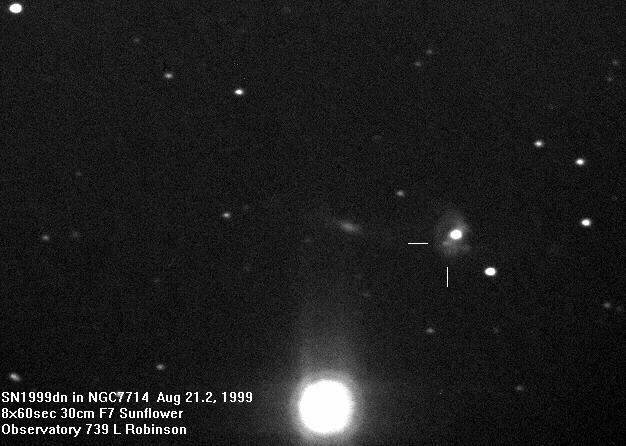
A composite image of this supernova from Sunflower Observatory.
SUPERNOVA 1999dn IN NGC 7714
Y. L. Qiu, Q. Y. Qiao, and J. Y. Hu, Beijing Astronomical Observatory (BAO), report their discovery, in the course of the BAO Supernova Survey, of an apparent supernova (mag about 16.0) in NGC 7714. SN 1999dn was discovered on two unfiltered CCD images taken on Aug. 19.76 and 19.82 UT with the BAO 0.6-m telescope, and it was confirmed on Aug. 20.65 with the BAO 0.60-m Schmidt telescope by X. Zhou and Z. Zheng. The new star is located at R.A. = 23h36m14s.70, Decl. = +2 09'08".8, which is 9".9 east and 9".4 south of the center of NGC 7714. This is a bright foreground star near NGC 7714. CCD frames taken on Aug. 10 (limiting mag about 18.0) show no object at the position of the supernova.
This new supernova was not as obvious as I would have hoped. The guiding was not my best
either. BUt it is there none the less. When I called up the DSS Image for comparison,
I noticed two trails on the DSS Image that look like asteroids. I wonder if anyone
ever measured and reported these? Here is the DSS Image.



SUPERNOVA 1999dg in UGC 9758
M. Modjaz and W. D. Li, University of California at Berkeley, on behalf of the Lick Observatory Supernova Search (cf. IAUC 6627, 7126), report the discovery with the 0.8-m Katzman Automatic Imaging Telescope (KAIT) of an apparent supernova in UGC 9758 (= MCG +02-39-007). SN 1999dg was discovered on unfiltered images taken on July 23.2 UT (mag about 16.7) and confirmed on images taken on July 24.2 (mag about 16.5). The new object is located at R.A. = 15h11m28s.41, Decl. = +13o29'05".7 (equinox 2000.0), which is 4".8 east and 5".2 north of the nucleus of UGC 9758. A KAIT image of the same field on July 15.2 (limiting mag about 19.0) showed nothing at the position of SN 1999dg.


SUPERNOVA 1999cw IN MCG -01-02-001 R. Johnson and W. D. Li, University of California at Berkeley, on behalf of the Lick Observatory Supernova Search (cf. IAUC 6627, 7126), report the discovery with the 0.8-m Katzman Automatic Imaging Telescope (KAIT) of an apparent supernova on unfiltered images taken on June 28.5 and 29.5 UT, both with mag about 14.2. The new object is located at R.A. = 0h20m01s.46, Decl. = -6o20'03".6 (equinox 2000.0), which is 21".1 east and 1".5 south of the nucleus of MCG -01-02-001. A KAIT image of the same field on 1998 Aug. 15.5 (limiting magnitude about 19.0) showed nothing at the position of SN 1999cw.

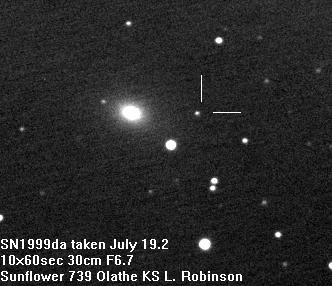

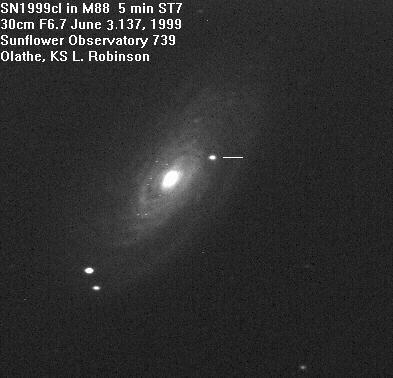
This bright SN in M88 was discovered by LOSS KAIT team. See IAUC 7185 for details. The host galaxy NGC 4501 is fairly nearby one (v_r is about 2500 km/s), so the expected SNeIa maximum would be order of 14 mag.
IAUC 7185 Date: Wed, 2 Jun 1999
SUPERNOVA 1999cl IN NGC 4501
M. Papenkova, A. V. Filippenko, and R. R. Treffers, University
of California at Berkeley, on behalf of the Lick Observatory
Supernova Search (cf. IAUC 6627, 7126), report their discovery of
an apparent supernova in an unfiltered image taken on May 29 UT
(mag 16.4) with the 0.8-m Katzman Automatic Imaging Telescope
(KAIT). The object was confirmed in images taken on May 30 and 31
(mag 16.2 and 15.3, respectively). Images from May 21 and 22 do
not show the object, to a limiting magnitude of 18.6. The
supernova candidate is at R.A. = 12h31m55s.9, Decl. = +14o25'33"
(equinox 2000.0), which is about 46" west and 23" north of the
nucleus of NGC 4501.
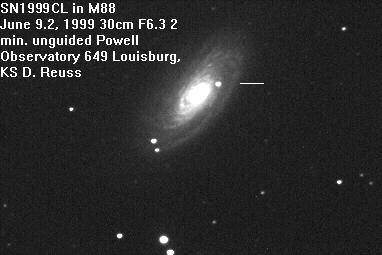
This is an image taken the night of JUne 8-9, 1999 by Donald Reuss with help from his sister, Jennifer and their dad, NIck. We were polar aligning the new 12" LX200 at Powell Observatory in Louisburg and needed to take a test image. Naturally, this made a nice subject. Getting brighter, huh?


Here is my first image taken on June 2, 1999. This is Mike Schwartz's 15th supernova discovery. Mike found this one in UGC 8539. According to IAUC 7178, the new object was found on May 22.27, when the magnitude was about 15.9 It is now about magnitude 14.8 This is an unusually bright supernova and is being watched carefully.
From IAUC 7178
Date: Mon, 24 May 1999
SUPERNOVA 1999cf IN UGC 8539 M. Schwartz, Cottage Grove, OR, reports his discovery of an apparent supernova (mag about 15.9) on an unfiltered CCD frame (limiting mag about 17) taken with the 0.35-m Tenagra I automated supernova patrol telescope at Sonoita, AZ, on May 22.27 UT, with a confirming observation on May 24.13. SN 1999cf is located at R.A. = 13h33m29s.71, Decl. = +33o03'22".9 (equinox 2000.0), which is about 7".9 east and 49".7 north of the center of UGC 8539. The new object does not appear on either the first Palomar Sky Survey digital image or on a CCD frame taken with the same equipment on 1998 June 28.28 (limiting mag 18.5).
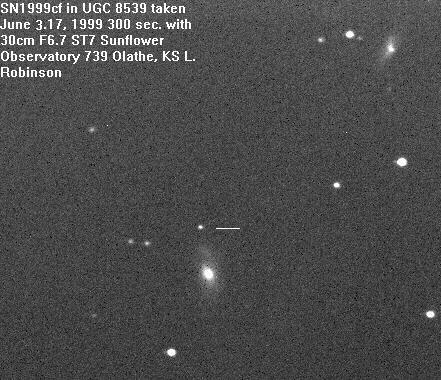
Here is a second image taken June 3, 1999. It appears to be getting brighter.

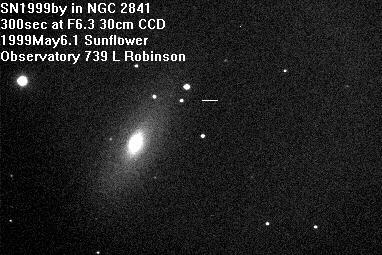
This looks like it could be the brightest supernova of 1999. Lots of people are looking at it visually with telescopes. By mid-May it is already up to mag 13.

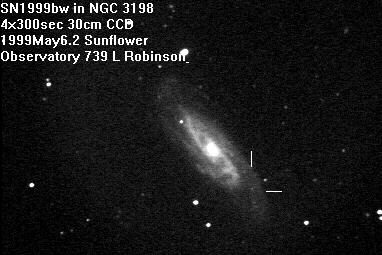
It took a composite of four several five minute exposures
to capture this extremely faint supernova.


This is a composite of five five minute guided exposures of SN1999be.
P. Nugent, Lawrence Berkeley National Laboratory, reported the
discovery of two supernovae, this one and SN1999bf, on unfiltered CCD images on behalf of
the Supernova Cosmology Project. A CCD spectrum by G. Aldering at the Cerro Tololo 4-m telescope on
Mar. 25 UT showed SN 1999be to be a type-Ia supernova, about 1 week
after peak brightness, at a recessional velocity of 5650 km/s,
similar to that of the host galaxy, CGCG 089-013.

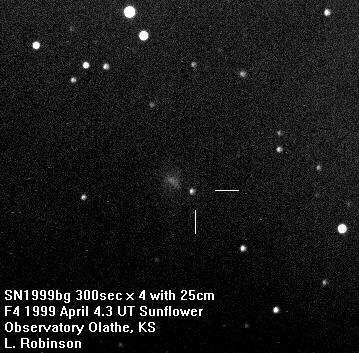
This is a composite of four five minute guided exposures of
SN1999bg in IC 758. SN 1999bg was found and
confirmed on unfiltered CCD frames taken on Mar. 28.3 and 29.3 UT
(mag about 15.5 on both dates) by W. Li, University of California
at Berkeley working with the Lick Observatory Supernova Search Team.

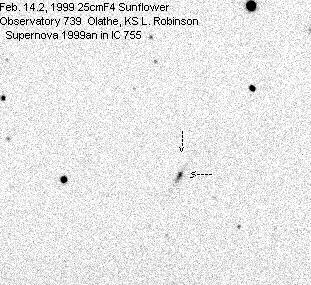
This is a sixty second unguided exposure of SN1999an in IC755.
Image was taken on 1999 March 14 at F4.07 with the 25.4 cm. This supernova
is a Type II and was discovered by the BAO Supernova Survey on Jan. 22, 1998.

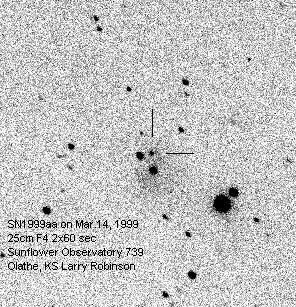
Here is a more recent image of SN1999aa taken on March 14, 1999.


This is a five minute guided image of NGC6063 with the recently discovered supernova. Image was
taken on 1999 February 28.09 at F4.07 with the 25.4 cm.


This image was produced by stacking five one minute unguided images and shows SN1999aa
discovered by Ron Arbour UK on Feb. 11, 1999. This is a type Ia mag 15.5.


This 5 minute guided exposure of the galaxy CGC 180-22 clearly shows the Type Ia mag 16.1 supernova discovered
by Mark Schwartz with his remote controlled Tenagra Observatory on
January 23, 1999. This is a Type Ia mag 16.1.

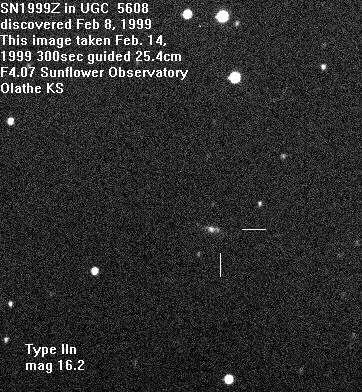
This 5 minute guided exposure of the galaxy UGC 5608 shows the supernova 1999Z which MArk discovered on
February 8, 1999. This is a rare Type IIn mag 16.2.

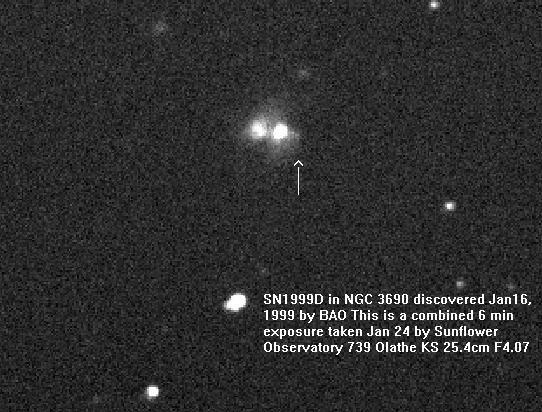
This 300 second guided exposure shows SN1999D discovered by Chinese astronomers.

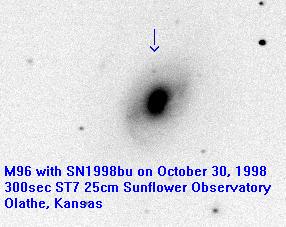
This 300 second image of M96 with supernova 1998bu was taken October 30, 1998 at 11:00:21 with the 25cm LX200
and ST7 at full 1x1 resolution at F4 and at temperature of -14.81C.
The supernova is brighter than expected this late and has created some
interest with the theorists. See New Info on SN1998bu for details.

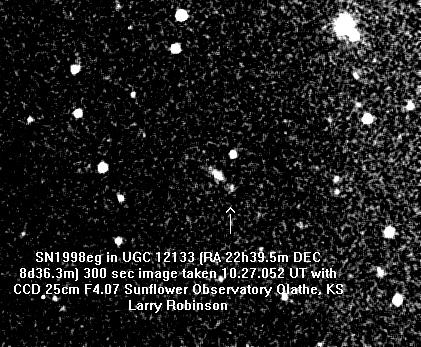
This 300 second image of UGC12133 with supernova was taken October 27, 1998 at 1:15:21 UT with the 25cm LX200
and ST7 at full 1x1 resolution at F4 and at temperature of -12.29C
and shows the supernova discovered a few days earlier. The supernova appears to have brightened somewhat since discovery.

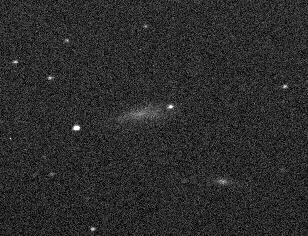
This 60 second negative image of NGC7541 with supernova was taken August 2, 1998 at 1:26:31 with the 25cm LX200
and ST7 at full 1x1 resolution at F4 and at temperature of -9.79C and shows the supernova discovered a few days earlier. The supernova is the
star at the right edge of the galaxy. The image has been cropped. When I used Astrometrics to measure the exact magnitude of the supernova I got
a measurement that was almost a full magnitude brighter than what everyone else was getting. I put it at 13.2 and everyone else was at 14.0 or dimmer.
I made the measurements many times with different reference stars using the USNO-SA1.0 catalog data and still came up with the same number. No one could explain it?

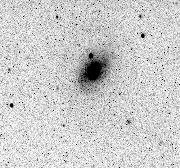
This 60 second negative image of M96 with supernova was taken on May 15
and shows the supernova discovered a few days earlier. I had imaged this
galaxy the day before it spawned this supernova. It was cloudy in Kansas
the night the supernova was discovered by Mirko Villi in Italy on May 9.9
using the same setup I have.


Here is my 60 second image of Supernova 1998S taken on April 23, 1998
with my LX200 10" operating at F4 using an ST7 with 2x2 binning. This
supernova continues to brighten and may be at it's maximum now.

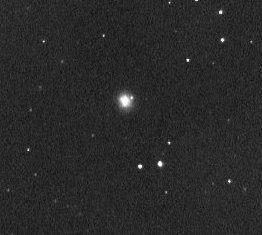
This is the discovery image of SN1998aq taken on April 13, 1998 by M. Armstrong, U.K.
SN1998aq is in NGC 3982 (R.A. 11h 56.4m DEC 55d 07.6m in the bowl of the big dipper.
The discovery was announced in IAUC no. 6875 on April 14, 1998.
The host galaxy, NGC 3982 is an Sbc type. The location of SN1998aq is
RA 11h 56m 26s DEC 55o07'38.8" and is approximately 18" west anf 7" north from the galaxy's
center.
On the Apr 13.8 exposure, the magnitude of SN1998aq was estimated to be 14.5 which would indicate
that this supernova is in a very early phase and should be getting brighter. According to
Hitoshi Yamaoka, Kyushu Univ., Japan, this galaxy is about the same distance
as the Virgo cluster and therefore SN1998aq can be expected to get much brighter
regardless of what type it is. The type is not yet known. Additional magnitude estimates have been
requested, so I imaged SN1998aq at Apr18.25UT to gain data to make some rough magnitude estimates and
following are my observations.

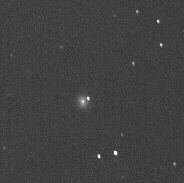
The image I took was made with an ST7 on an LX200 10" at F4 for 60 seconds at -19.98C. It
has been dark subtracted, flat corrected and histogram stretched to bring
out details. Supernova 1998aq is very obvious. When I looked at the
pixel density of SN1998aq I got a maximum reading of 2213 on this image.
GSC 3836:20, the mag 13.0 star to the SSW was 2990, a little brighter.
GSC 3836:79, the mag 13.6 star to the NW was 1858, a little dimmer. This
means SN1998aq has already gotten MUCH brighter, about mag 13.5!

My friend David Hudgins went out Saturday night, April 18 and observed SN1998aq using his telescope
and did a nice drawing and write up, which you can see by clicking
here. David was the original owner of my LX200 10".
He recently retired from his engineering job and is now teaching astronomy
at a local university.

Here is an interesting email from Steve Lucas with ISN:
Supernovae Collegues:
As a compliment to Mr. Hitoshi's excellant nomenclature of the host galaxy
for SN 1998aq, I might add that NGC 3982 is also considered a member of the
Ursa Major I North Cloud, a lesser of four clouds (South, X, and Z) (from
an unpublished article by James T. Bryan and Harold G. Corwin Jr., _Atlas
of the Ursa Major I North Cloud_, released in 1989). The V (subset t)
photoelectric magnitude for the entity is given as 11.1, the B-V (subset T)
Color Index=0.7, the surface brightness per square arc minute at the major
isophotal diameter=12.7.
This Cloud "has a membership of 37 galaxies of which 32 are spirals, 2 are
lenticular, 1, is irregular, 1 is elliptical and 1 is peculiar. Some
noteworthy galaxies residing within this cloud are: NGC's 3631(SNe 1964A,
SN1965L), 3733 (SN1980D), 3756 (SN1975T), 3913 (SNe 1963J, SN 1979B), 3992
(SN 1956A), Anon.1156+5259 (SN 1964E), and 4102 (SN 1975E). The Distance
Modulus on an average for six galaxies= 31.13, which yields a distance of
~16.8 Mpc (The major diameter of the Cloud is 11.1 degrees or 3.3 Mpc).
This yields an estimated Hubble parameter of 72.5 km/sec/Mpc in the
vicinity of the Cloud by implementing the formula V avg.=1218 km/sec/Mpc
(based on an average of 37 radial velocites) / the distance (Dmpc)=16.8
Mpc".
A supernova in this Cloud (per the abovementioned paper) would be ~12.6 for
a type I, and ~14.6 for a type II (this infers a Mv= -18.5 and -16.5
respectively), which agrees well with Mr. Hitoshi's findings.
--------------------------------------------
Addendum: In my posted message of 3/28/98 to VSNET, and ISN chats there is
an error regarding the galaxy NGC 3877....
>>"The distance modulus is ~31.37 (Ho=50km/sec per Mpc) yielding an
approximate distance of 25MLY (24,600,081)"<<.
This should read: ~18.79 Mpc, or ~61M light years. Thanks to Stan Howerton
for the note, and keeping me honest
Here is my image of SN1998sn in UGC3683. This is a 60 second image taken with ST7 on my LX200 10" at F4.
The moon was very bright when this image was taken on April 11, 1998, yet it is quite obvious.

SN1998an
